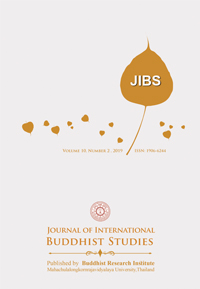Synergy of Buddhism: A Catalyst to Improve Cultural Ecology
Keywords:
Synergy, Buddhism, Catalyst, Improve, Cultural, Ecology-Abstract
The terms Hinayana (Theg-dman) and Mahayana (Theg-chen), meaning modest or “lesser” vehicle and vast or “greater” vehicle, first appeared in The Sutras on Far-reaching Discriminating Awareness (Sherphyin- gyimdo, Skt. Prajnaparamita Sutras; The Perfection of Wisdom Sutras), as a way of expressing the superiority of Mahayana. Historically, there were eighteen schools that predated Mahayana, each with its own slightly different version of the monastic rules of discipline (‘ dul-ba, Skt. vinaya). Although some have suggested alternative names to refer to the eighteen as a whole, we shall use the more commonly known term Hinayana for them, but without intending any pejorative connotation. Before the Buddha’s Parinirvanana, he had told Ananda that if the Sangha wished to amend or modify some minor rules, they could do so. But Ananda forgot to ask the Buddha what the minor rules were. As the members of the Council were unable to agree as to what constituted the minor rules, MahaKassapa finally ruled that no disciplinary rule laid down by the Buddha should be changed, and no new ones should be introduced. No intrinsic reason was given. MahaKassapa did say one thing, however: “If we changed the rules, people will say that Ven. Gautama’s disciples changed the rules even before his funeral fire has ceased burning.” At the Council, the Dharma was divided into various parts and each part was assigned to an Elder and his pupils to commit to memory. The Dharma was then passed on from teacher to pupil orally. The Dharma was recited daily by groups of people who regularly cross-checked with each other to ensure that no omissions or additions were made.
References
For Hsuan Tsang’s travel narrative, see the translation by Samuel Beal, Si-Yu Ki: Buddhist Records of the Western World (London: Trubner& Co., 1884; reprint ed., Delhi: Oriental Books Reprint Corporation).
Vasant Moon, compiler and ed., Babasaheb Ambedkar, Writings and Speeches (Bombay: Government of Maharashtra,1987), Vol. 3, pp. 232-33.
S. R. Goyal, A History of Indian Buddhism (Meerut, 1987), p. 394.
Detlef Kantowsky, Buddhists in India Today: Descriptions, Pictures and Documents(Delhi: Manohar, 2003), p. 156.
Padmanabh S. Jaini, “The Disappearance of Buddhism and the Survival of Jainism: A Study in Contrast”, in Studies in History of Buddhism, ed. A. K. Narain (Delhi: B. R. Publishing Co., 1980), pp. 181-91.







